Chromosome Abnormalities: Beyond Traditional Karyotyping
Simon Park
Simon Park*
Department of Obstetrics and Gynaecology, Temple University, USA
- *Simon Park:
- Simon Park
Department of Obstetrics and Gynaecology
Temple University, USA
E-mail: parksimon@ym.edu.tw
Received Date: November 09, 2021; Accepted Date: November 23, 2021; Published Date: November 30, 2021
Citation: Park S (2021) Chromosome Abnormalities: Beyond Traditional Karyotyping. J Contracept Stud Vol 6 No.11:17.
Pregnancy loss is a heart-breaking and emotionally draining experience for any marriage. Aside from dealing with what may be a couple's psychosocial embarrassment as a result of their loss, one of the biggest hurdles for most studies is distinguishing between cases of pregnancy loss owing to genetic flaws that are destined to miscarry and cases that are treatable. The gold standard for prenatal diagnosis, including pregnancy loss, is unquestionably chromosomal karyotyping. Microarray analyses, also known as molecular karyotyping and chromosomal array analysis, including array-based comparative genomic hybridization and Single Nucleotide Polymorphism (SNP) array, can provide nearly the same or better diagnostic information for detecting gains and losses of genetic material across the genome. A genome scanning panel is made up of all of these various arrays. Without prior information of chromosomal gains or losses, comparative genomic hybridization can discover and map genomic areas for chromosomal gains or losses in a single experiment.
The performance of single nucleotide polymorphism array over conventional karyotyping in analysing products of conception, which can be found in this issue. We appreciate the publishing of this paper because the findings were in line with prior publications based on classical cell culture and karyotyping of foetal products. Approximately 64.5% (100/155) of samples research were cytogenetically aberrant (including 52% single trisomy, 11% monosomy X, and 6% triploidy). When compared to conventional karyotyping (G-banded karyotyping), the SNP array not only had a higher success rate for detecting chromosomal abnormalities (98.1% vs. 85.8%), but it also had the ability to detect pathologic copy number variations and whole-genome uniparental disomy (UPD), contributing to a higher detection rate of abnormalities (62.6% vs. 61.3%).
Furthermore, the use of SNPs boosted mosaicism sensitivity substantially, two cases of chromosomal translocation and one case of chromosome translocation. SNPs, according to the authors, could be a viable alternative to in clinical genetics, karyotyping is used. Permanent, in fact, just released a fascinating research in which they The Next-generation Aneuploidy Test was used to examine 1064 maternal blood samples from 7 weeks of pregnancy and beyond The SNPs algorithm was used. The test produced results with a high level of sensitivity and specificity, according to this investigation specificity. In addition, it reported on the entire cohort of in a large-scale cohort of post miscarriage products of-conception samples evaluated utilising a high-resolution SNP based microarray platform, recognisable abnormalities, regardless of known clinical significance, were identified. They came to the conclusion that employing SNPs was beneficial.
In clinical genetics, karyotyping is a useful tool. Permanent is, in fact it released a fascinating research not long ago. Using the Nextgeneration Aneuploidy Test, researchers looked at 1064 maternal blood samples from 7 weeks onwards. SNPs algorithm is being used. The test yielded data with a high level of sensitivity and specificity, according to this study. Specificity this also reported on the entire cohort of a large-scale cohort of post miscarriage products-of-conception samples evaluated utilising a highresolution SNP based microarray platform revealed recognisable abnormalities, regardless of known clinical significance. They came to the conclusion that SNPs could be useful in their research. Increases the number of defects that can be detected in the genome and enables real foetal results to be reported more easily, and encourages the adoption of cytogenomic study using SNP chromosomal microarrays when clinically warranted, assessment of miscarriage specimens
Open Access Journals
- Aquaculture & Veterinary Science
- Chemistry & Chemical Sciences
- Clinical Sciences
- Engineering
- General Science
- Genetics & Molecular Biology
- Health Care & Nursing
- Immunology & Microbiology
- Materials Science
- Mathematics & Physics
- Medical Sciences
- Neurology & Psychiatry
- Oncology & Cancer Science
- Pharmaceutical Sciences
